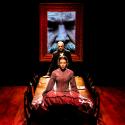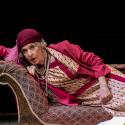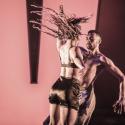Marc Rees (b 1966) is an interdisciplinary artist-performer from Wales whose works are renowned for imaginitively mixing media, as well as for their underlying sense of fun. Over the years he has been based in Berlin, Amsterdam and Canada, and now runs the collaborative arts company RIPE (Rees International Project Enterprizes). He has worked with international talent such as DV8 Physical Theatre, Brith Gof and German dancer-choreographer Thomas Lehman, and has, in recent years, presented pieces ranging from Adain Avion, a contribution to the Cultural Olympiad of 2012, which involved transporting the fuselage of a DC9 aeroplane around the country, 2013’s Tir Sir Gâr, a multimedia theatre event based around contemporary farm life that won a plethora of awards, and (150), last year’s National Theatre Wales epic about the Welsh emigration to Patagonia.
THOMAS H GREEN: Tell us about Digging for Shakespeare.
MARC REES: It’s based on this extraordinary character who I discovered through an article in the Guardian entitled “Shakespeare’s Scholar Tramp” which immediately hooked me into reading about this extraordinary guy, James Orchard Halliwell-Phillipps, who lived on the outskirts of Brighton in the late 19th century in a series of conjoining sheds. He was one of world’s greatest Shakespeare scholars, an eccentric character, a recluse. I went to look for where his dwelling was, or could have been – although I knew it was no longer there. Wandering through these woods I came across this extraordinary sight, the community of the Roedale Allotments, which contained a huge number of sheds. I thought, “Wouldn’t it be great to work with the alottmenteers and have this as a location for an immersive site-specific experience based on this character." I knew it was the 400th anniversary of Shakespeare’s death so I thought it would be a really interesting combination to bring Shakespeare and allotments together in one piece.
And the allotmenteers welcomed the idea?
Totally. This is Brighton, right! It’s such an extraordinary space and, also, allotments draw in such an unusual mix of people who are, perhaps, more open. I’ve taken a year to go there regularly, once or twice a month, to hang out and have tea with them. I particularly work with one guy called Amos who’s an amazing coordinator. He straightaway said, “That’s brilliant, lets do it!” They’re really intrigued because it highlights Shakespeare’s links to planting, which are peppered throughout his plays.
Would you be surprised to learn that at the Festival launch there was a very audible hum of amusement when it was announced this performance would involve Shakespearean characters rendered in wool?
I highlight that certain plays feature certain plants. We are growing those plants now. They’re being grown by the allottmenteers and will be displayed along with the related quote from that play. I thought, “We need to see a character from each play,” but we couldn’t afford actors. Originally my idea was to use Brighton eccentrics like [dancer-choreographer] Liz Aggiss, [high kitsch entertainer] Boogaloo Stu [author] Louise Rennisson but we couldn’t do that. I had worked on a previous piece, which was a reimagining of Under Milk Wood by Dylan Thomas in Laugharne, where I met this lady who’d been knitting her way through the characters. It was so fantastic the way she captured them so I thought, “I’m going to commission her to create 12 Shakespeare characters." She has lovingly been knitting them for a year. I think her first one was Bottom, the one with the donkey’s head from A Midsummer Night’s Dream. They’re beautiful, but humorous as well. I wanted Digging for Shakespeare to be a trail of discovery where you find these characters in 12 sheds representing the 12 months of the gardening season. You discover the plants and these characters but you can also gather gardening tips, and there’s a chance to meet and chat to the alottmenteers. The thing is you don’t have to visit all 12. If you visit three or four, you’ll get the essence of the piece. It’s bookended with the fact you’ll meet James Orchid Halliwell-Phillipps himself, embodied by a Spanish performer-dancer who’s amazing, and you’ll have a lecture from Charles Nicholl who wrote the original article, "Shakespeare’s Scholar Tramp". It’ll be quite informative, but a fun thing as well.
What do you make of Brighton?
I love Brighton. When I went to Brighton Polytechnic in the Eighties it had a tremendous impact, especially working with Liz Aggiss, who is still performing. She was such a formidable teacher and mentor. She introduced me to that potential of what performance and visual arts could be. I owe Brighton a lot.
Do you have any special memories of Brighton in Eighties?
I grew up in a small village in Wales and my father was a miner. I wasn’t a conventional person, I was quite unusual, but I came across Brighton, came to the college. It was a real culture shock. It made me feel welcome and somehow I found myself. It's a place that does have eccentrics and I think my personality came to fruition there, from seeing art, performance, going to the Zap Club, the people on the course. I was very fortunate to known Louise Rennison who just recently died. She wrote Angus, Thongs and Full Frontal Snogging, these amazing books. It was so fantastic to hang out with her and her friends. Even though they were much older than me, they introduced me to this amazing world of art.
Over the years, why have your parents cropped up a lot in your art?
Funnily enough, moving away I realised how important my parents were. I thought, “How can I use that connection?” I realised how important that was to creativity so I latched onto that and used it. Liz Aggiss used to call me “the little Welsh boy” and I couldn’t help thinking that was patronizing, even though I knew she was provoking me, so I decided to make work about Wales, about home, although not so much anymore. I’d have my father perform in a show with me, and actually I’m fascinated with sheds - I realised last week that this links back to my father. Inevitably things become about your upbringing or your parents. Even now, as a 50 year old man, they still have influence on what I make.
Do you still see a lot of them?
My father died 10 years ago but I see my mother semi-regularly. I’m busy and I live in Cardiff so I don’t get to her in Swansea but I try to talk to her every day. She’s 86. My parents were extraordinarily supportive, they gave me freedom I even remember being in college and writing an essay. I called up my father and asked him to send me a whole box of earth from his garden which he did. I buried the essay in this earth and gave it to the tutor. My father didn’t bat an eyelid. He just sent me this massive box of earth. I wanted to reconnect with home and present it in a different way. I’ve always been interested in reconfiguring history. I describe myself as an archaeologist, exhuming multi-layered inner sites, discovering things and representing them in unusual ways.
What other projects have you got on?
I have been working in Llandudno in north Wales which is like a mini-Brighton. I’ve been curating a festival there for the last three years and I have a tabernacle chapel at my disposal. I’ve been asked to programme that, a series of residencies and performances.
If you had a time machine and could go back somewhere for 24 hours, where would you go?
You know what, I think I’d go to Brighton back in the Eighties. I am realising how important it was, how formative, so I’d go back there one more time just to experience that again.
You have a very particular look. Do you find it irritating when other people – especially the oft-mentioned “hipsters” - adopt that look?
It’s not a unique look. I didn’t invent it. That’s why I like being in Brighton, I see people who are similarly dressed and that makes me feel I’m in a kind of club. I’ve always been interested in fashion. When I came to Brighton it was the Eighties. Punk was over, it was the start of the new romantics, so I started to mess around with that. Obviously now I’m 50 I can’t dress up like that. I’ve adapted a more gentlemanly but distinctive and borderline eccentric look.














Add comment